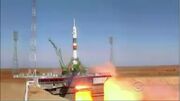
Soyuz Rocket Launch
Soyuz (rocket family)|Soyuz (Russian: Союз, meaning "union") is a family of expendable launch systems developed by OKB-1, and manufactured by TsSKB-Progress in Samara, Russia. According to the European Space Agency, the Soyuz launch vehicle is the most frequently used launch vehicle in the world.
The Soyuz vehicles are used as the launcher for the manned Soyuz (spacecraft)|Soyuz spacecraft as part of the Soyuz program, as well as to launch unmanned Progress supply spacecraft to the International Space Station and for commercial launches marketed and operated by Starsem and Arianespace. All Soyuz rockets use RP-1 and liquid oxygen (LOX) propellant, with the exception of the Soyuz-U2, which used Syntin, a variant of RP-1, with LOX.

Russia's Soyuz Crew Ferry Spacecraft
The launcher was introduced in 1966, deriving from the Vostok launcher, which in turn was based on the 8K74 or R-7a rocket|R-7a intercontinental ballistic missile. It was initially a three-stage rocket with a Block I upper stage. On the first manned flight Soyuz 1, cosmonaut Vladimir Komarov lost his life during a descent accident.
The production of Soyuz launchers reached a peak of 60 per year in the early 1980s. It has become the world's most used space launcher, flying over 1700 times, far more than any other rocket. It is a very old basic design, but is notable for low cost and very high reliability, both of which appeal to commercial clients.
Between February 1, 2003 and July 26, 2005 with the grounding of the US Space Shuttle fleet, Soyuz was the only means of transportation to and from the International Space Station. This included the transfer of supplies, via Progress spacecraft, and crew changeovers. Now that the Space Shuttle fleet is retired, the American space program is without any means to boost men into orbit, and NASA is entirely dependent on the Soyuz to send crew into space for the immediate future.
The main payload for the Soyuz Rocket is a series of spacecraft initially designed for the Soviet space program by the Korolyov Design Bureau in the 1960s, and still in service today.
The first unmanned Soyuz mission was launched November 28, 1966; the first Soyuz mission with a crew (Soyuz 1) was launched April 23, 1967, but the cosmonaut on board, Vladimir Komarov, died during the flight's crash-landing. Soyuz 2 was an unmanned mission, and Soyuz 3, launched on October 26, 1968, was the first successful Soyuz manned mission. The only other fatal mission, Soyuz 11, killed the crew of three also during re-entry due to premature cabin depressurization. Despite these early fatalities, Soyuz is presently widely considered the world's safest, most cost-effective human spaceflight system as demonstrated by its unparalleled length of operational history.
Soyuz spacecraft were used to carry astronauts to and from Salyut and later Mir Soviet space stations, and are now used for transport to and from the International Space Station (ISS).At least one Soyuz spacecraft is docked to ISS at all times for use as an escape craft in the event of an emergency.
The Soyuz spacecraft is intended to be replaced by the six-person Prospective Piloted Transport System.
Use by Howard to go to the ISS when launched from Kazakhstan.
